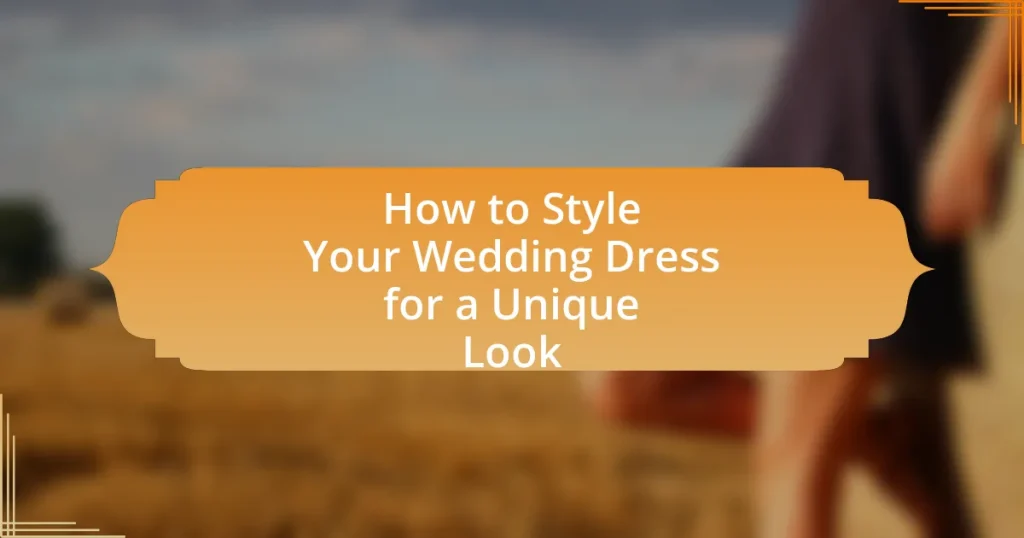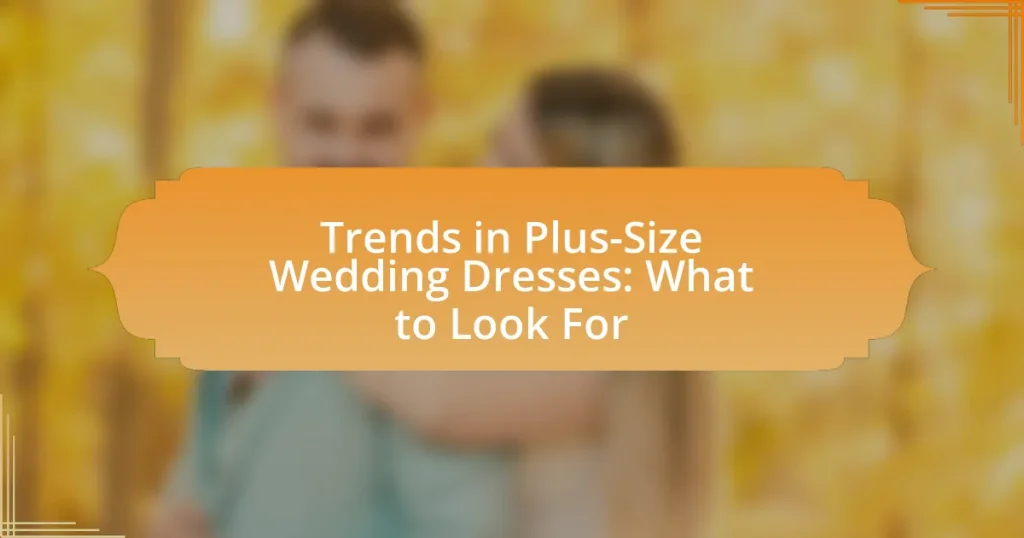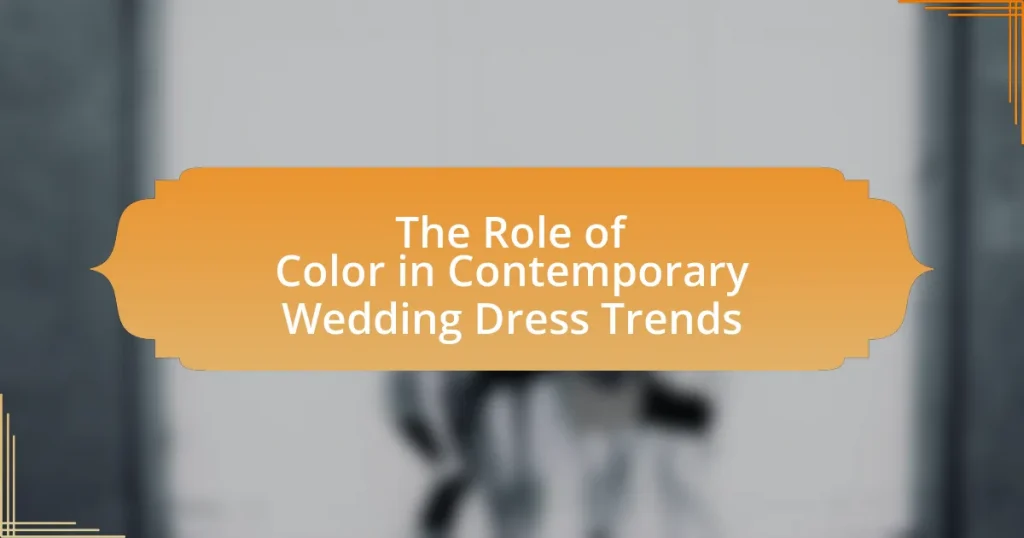The article focuses on how to style a wedding dress for a unique look, emphasizing the importance of personalization through custom alterations, fabric choices, and accessories. Key elements discussed include silhouette, fabric, color, embellishments, and accessories, all of which contribute to creating a cohesive and individualized bridal attire. The article also explores the impact of fabric choices and embellishments on the overall style, as well as current trends that inspire unique wedding dress designs. Additionally, it provides practical tips for incorporating personal touches, layering techniques, and mixing different styles to achieve a distinctive appearance on the wedding day.
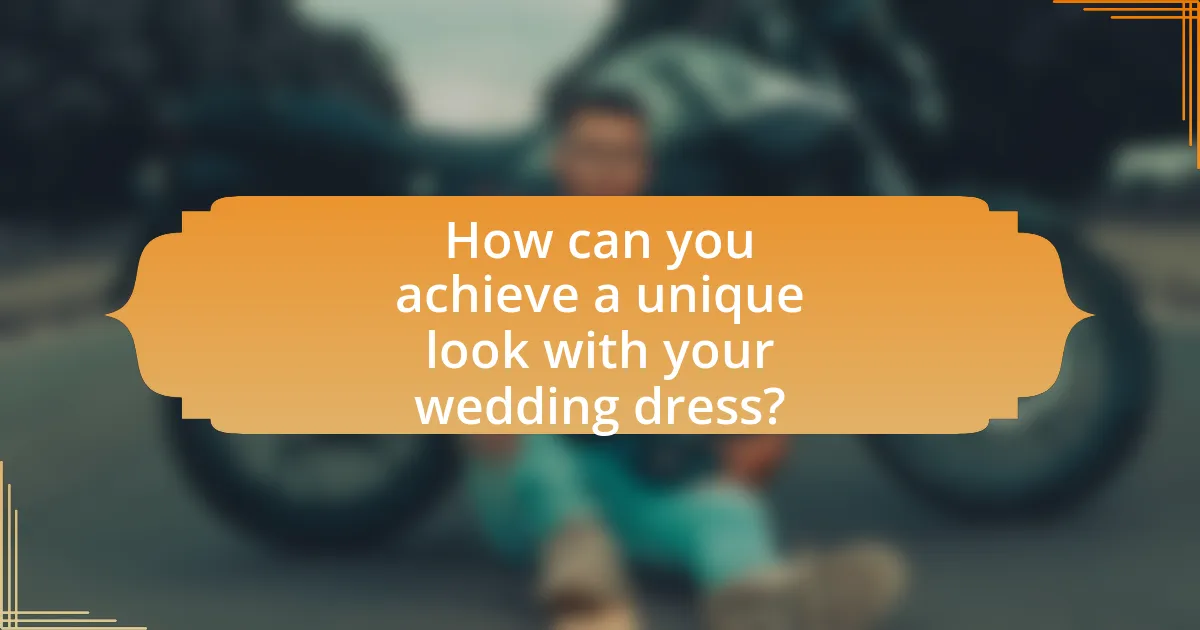
How can you achieve a unique look with your wedding dress?
To achieve a unique look with your wedding dress, customize it through alterations, fabric choices, and accessories. Custom alterations can include changing the neckline, adding sleeves, or modifying the silhouette to reflect personal style. Selecting unique fabrics, such as lace, silk, or even unconventional materials, can set your dress apart. Additionally, incorporating distinctive accessories like a statement veil, personalized jewelry, or custom embroidery can enhance individuality. These methods are supported by trends in bridal fashion, where personalization has become increasingly popular, allowing brides to express their unique identities on their special day.
What are the key elements to consider when styling your wedding dress?
The key elements to consider when styling your wedding dress include silhouette, fabric, color, embellishments, and accessories. The silhouette determines the overall shape and fit of the dress, which can enhance or detract from the bride’s figure. Fabric choice affects the dress’s drape and comfort; for example, silk offers elegance while lace adds texture. Color can convey personal style and theme, with options ranging from traditional white to bold hues. Embellishments like beading or embroidery can add visual interest and uniqueness. Finally, accessories such as veils, jewelry, and shoes complete the look, allowing for personal expression. Each of these elements plays a crucial role in creating a cohesive and personalized wedding attire.
How do fabric choices influence the overall style of your wedding dress?
Fabric choices significantly influence the overall style of a wedding dress by determining its silhouette, texture, and drape. For instance, silk creates a luxurious and flowing appearance, while lace adds a romantic and vintage feel. Additionally, heavier fabrics like satin provide structure, enhancing a formal look, whereas lighter materials such as chiffon contribute to a more ethereal and soft aesthetic. The interplay of these fabrics can also affect how the dress moves and fits, further shaping the bride’s overall presentation on her wedding day.
What role do embellishments play in creating a unique wedding dress look?
Embellishments play a crucial role in creating a unique wedding dress look by adding distinctive features that enhance the overall design. These decorative elements, such as lace, beading, embroidery, and appliqués, allow for personalization and can transform a standard dress into a one-of-a-kind piece. For instance, a study by the Fashion Institute of Technology highlights that intricate embellishments can significantly increase the perceived value and uniqueness of a garment, making it stand out in a sea of traditional designs.
Why is personalization important in styling your wedding dress?
Personalization is important in styling your wedding dress because it ensures that the dress reflects the bride’s unique identity and preferences. A personalized wedding dress allows for the incorporation of specific elements such as fabric choice, color, and design details that resonate with the bride’s style, making the dress not just a garment but a representation of her individuality. Studies show that personalized experiences enhance emotional connections; thus, a custom-styled wedding dress can significantly increase the bride’s satisfaction and confidence on her special day.
How can you incorporate personal touches into your wedding dress design?
To incorporate personal touches into your wedding dress design, you can customize elements such as fabric, color, and embellishments to reflect your personality and story. For instance, choosing a fabric that holds sentimental value, like lace from a family heirloom, can add emotional significance. Additionally, selecting a unique color palette that resonates with your style or incorporating personal symbols through embroidery or appliqués can further personalize the dress. According to a survey by The Knot, 70% of brides opt for customizations to make their wedding attire unique, highlighting the trend of personalization in wedding fashion.
What are some examples of personalized wedding dress styles?
Personalized wedding dress styles include custom silhouettes, unique fabric choices, and personalized embellishments. Custom silhouettes allow brides to choose designs that flatter their body shape, such as A-line, mermaid, or ball gown styles tailored to individual preferences. Unique fabric choices, like lace, satin, or tulle, can be selected based on personal taste and comfort. Personalized embellishments, such as custom embroidery, beading, or appliqués, can reflect the bride’s personality or cultural heritage, making the dress truly one-of-a-kind. These elements combine to create a wedding dress that is not only stylish but also deeply personal to the bride.
What trends can inspire a unique wedding dress style?
Current trends that can inspire a unique wedding dress style include the use of non-traditional colors, sustainable fabrics, and innovative silhouettes. Non-traditional colors, such as blush, navy, or even black, allow brides to express individuality, as seen in recent collections from designers like Vera Wang, who has incorporated darker hues into her bridal lines. Sustainable fabrics, such as organic cotton or recycled materials, reflect a growing awareness of environmental impact, with brands like Reformation leading the way in eco-friendly wedding attire. Innovative silhouettes, including asymmetrical hemlines and two-piece designs, offer modern alternatives to classic styles, as evidenced by the popularity of separates in recent bridal fashion weeks. These trends collectively provide diverse options for brides seeking a distinctive look on their wedding day.
How do current fashion trends impact wedding dress styling?
Current fashion trends significantly influence wedding dress styling by dictating popular silhouettes, fabrics, and embellishments. For instance, the rise of minimalist aesthetics has led to an increase in demand for sleek, simple designs, often featuring clean lines and understated elegance. Additionally, trends such as bohemian styles have popularized flowing fabrics and intricate lace details, reflecting a shift towards more relaxed and personalized wedding themes. According to a survey by The Knot, 45% of brides in 2022 opted for non-traditional wedding dresses, showcasing how contemporary fashion trends are reshaping traditional expectations in bridal wear.
What are some timeless styles that can be modernized for a unique look?
Timeless styles that can be modernized for a unique look include the A-line silhouette, lace detailing, and vintage-inspired designs. The A-line silhouette, known for its universally flattering shape, can be updated with contemporary fabrics or asymmetrical hemlines to create a fresh appearance. Lace detailing, traditionally associated with classic bridal gowns, can be modernized by incorporating bold patterns or contrasting colors, enhancing visual interest. Vintage-inspired designs, such as those from the 1920s or 1970s, can be reimagined with modern cuts and accessories, allowing brides to express individuality while honoring timeless aesthetics. These adaptations not only maintain the essence of classic styles but also cater to current fashion trends, making them relevant for today’s brides.

How can accessories enhance your wedding dress style?
Accessories can enhance your wedding dress style by adding personal flair and elevating the overall aesthetic. For instance, statement jewelry can draw attention to the neckline and complement the dress’s design, while a veil can create a romantic and traditional look. Additionally, accessories like belts can define the waist, and unique shoes can add a pop of color or texture, making the outfit more visually interesting. According to bridal fashion experts, the right accessories can transform a simple gown into a personalized masterpiece, showcasing the bride’s individuality and style preferences.
What types of accessories should you consider for your wedding dress?
For your wedding dress, consider accessories such as veils, tiaras, jewelry, belts, and shoes. Veils can add elegance and tradition, while tiaras or hairpins can enhance your hairstyle and overall look. Jewelry, including earrings and necklaces, should complement the dress without overwhelming it. A decorative belt can define your waist and add a unique touch, and the choice of shoes can reflect your personal style while ensuring comfort throughout the day. Each accessory plays a crucial role in creating a cohesive and personalized bridal look.
How do veils and headpieces complement your wedding dress?
Veils and headpieces enhance a wedding dress by adding layers of elegance and personal style. They serve as accessories that can either match or contrast with the dress, creating a cohesive look that highlights the bride’s overall aesthetic. For instance, a lace veil can complement a lace wedding gown, while a jeweled headpiece can add sparkle to a simple dress. This combination not only frames the bride’s face but also draws attention to her hairstyle, making the entire ensemble more visually appealing.
What jewelry works best with different wedding dress styles?
Different wedding dress styles pair best with specific types of jewelry to enhance the overall look. For a classic A-line dress, pearl earrings and a simple pendant necklace create an elegant touch. A fitted mermaid gown complements statement earrings and a bold cuff bracelet, adding drama to the silhouette. For bohemian-style dresses, layered necklaces and natural stone jewelry reflect a relaxed vibe. Vintage lace gowns are beautifully accented with antique-inspired pieces, such as a brooch or chandelier earrings. Each jewelry choice aligns with the dress style, ensuring a cohesive and stylish appearance.
How can shoes impact the overall look of your wedding dress?
Shoes significantly impact the overall look of a wedding dress by influencing the dress’s silhouette, color coordination, and style cohesion. The choice of shoe height can alter the dress’s length perception, while the color and design of the shoes can either complement or clash with the dress, affecting the overall aesthetic. For instance, a classic white wedding dress paired with elegant ivory heels creates a seamless look, whereas bold-colored shoes can add a pop of personality and contrast. Additionally, the style of the shoes, whether they are modern, vintage, or bohemian, can enhance or detract from the dress’s theme, ultimately shaping the bride’s overall appearance on her special day.
What styles of shoes are best suited for various wedding dress designs?
For various wedding dress designs, the best-suited shoe styles include classic pumps for A-line dresses, strappy sandals for mermaid gowns, and ballet flats for tea-length dresses. Classic pumps complement the structured silhouette of A-line dresses, providing elegance and height. Strappy sandals enhance the fitted nature of mermaid gowns, adding a modern touch while allowing for movement. Ballet flats are ideal for tea-length dresses, offering comfort and a playful vibe that matches the dress’s style. These shoe choices align with the overall aesthetic of each dress type, ensuring a cohesive look on the wedding day.
How can the color of your shoes add uniqueness to your wedding outfit?
The color of your shoes can add uniqueness to your wedding outfit by serving as a distinctive accent that contrasts or complements your dress. For instance, choosing a bold color like red or blue can create a striking visual impact, making the shoes a focal point of the ensemble. This approach is supported by fashion trends that emphasize personalized details, as seen in bridal fashion shows where non-traditional colors are increasingly featured. By selecting shoes in a unique hue, brides can express their individual style and make a memorable statement on their special day.
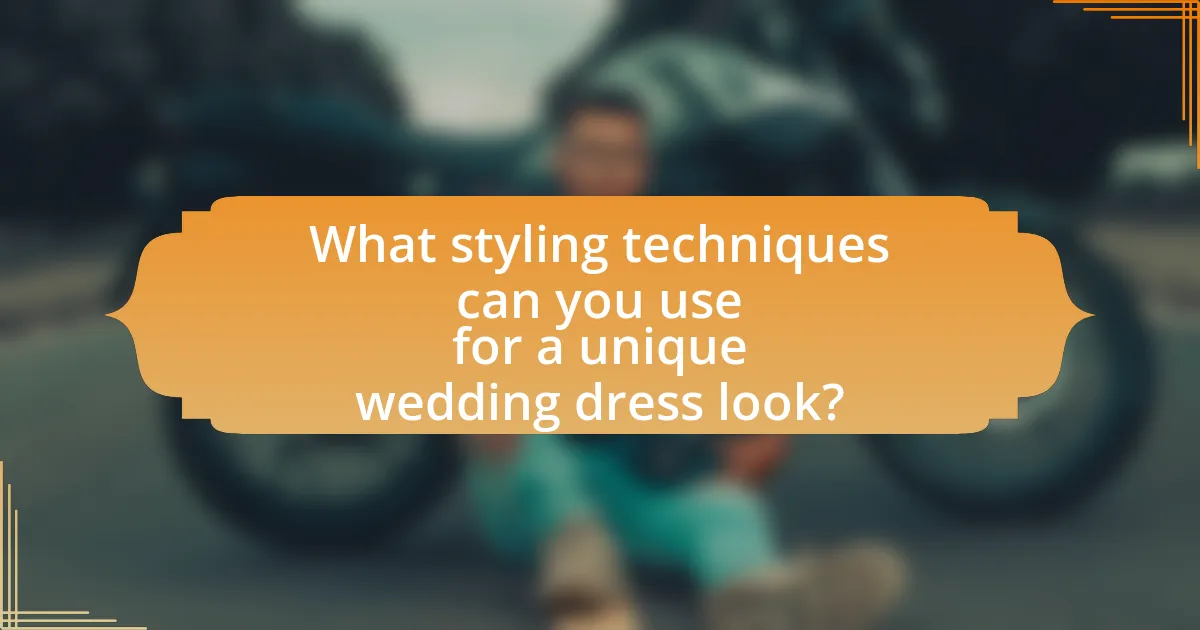
What styling techniques can you use for a unique wedding dress look?
To achieve a unique wedding dress look, consider incorporating layering, unconventional fabrics, and personalized accessories. Layering can involve adding a stylish cape or overskirt, which transforms the dress’s silhouette and adds dimension. Using unconventional fabrics, such as lace, tulle, or even metallic materials, can create a distinctive texture and visual interest. Personalized accessories, like custom jewelry or a unique veil, can further enhance the overall appearance, making the look truly one-of-a-kind. These techniques are widely recognized in the fashion industry for their effectiveness in creating standout bridal styles.
How can layering change the appearance of your wedding dress?
Layering can significantly change the appearance of your wedding dress by adding depth, texture, and dimension. For instance, incorporating layers such as tulle, lace, or chiffon can create a more voluminous silhouette, enhancing the overall aesthetic. Additionally, layering can introduce contrasting colors or patterns, allowing for a unique and personalized look. According to bridal fashion experts, layered designs can also provide versatility, enabling brides to transition from a formal ceremony to a more relaxed reception by removing or adjusting layers.
What are some creative layering options for wedding dresses?
Creative layering options for wedding dresses include adding a detachable overskirt, incorporating a lace or tulle cape, and using a structured bolero or jacket. Detachable overskirts allow brides to transform their look from ceremony to reception, providing versatility while maintaining elegance. Lace or tulle capes can add a romantic touch and can be easily removed for a more streamlined appearance. Structured boleros or jackets offer a modern twist and can provide warmth or coverage, enhancing the overall silhouette. These layering options not only personalize the wedding dress but also allow for unique styling that reflects individual tastes.
How does layering affect comfort and mobility on your wedding day?
Layering enhances comfort and mobility on your wedding day by allowing for temperature regulation and ease of movement. When a wedding dress incorporates layers, such as a detachable skirt or an overlay, it provides the bride with options to adjust her outfit according to the venue’s climate or her activity level. For instance, a lighter inner layer can be worn during the ceremony, while a more elaborate outer layer can be added for the reception, ensuring the bride remains comfortable throughout the day. Additionally, layers can facilitate greater freedom of movement, as they can be designed to allow for a wider range of motion, which is essential for dancing and mingling. This adaptability is supported by the fact that many bridal designers emphasize the importance of functional design in wedding attire, ensuring that brides can enjoy their special day without feeling restricted.
What are some tips for mixing and matching wedding dress styles?
To effectively mix and match wedding dress styles, consider combining different silhouettes, fabrics, and embellishments to create a cohesive yet unique look. For instance, pairing a fitted bodice with a flowing skirt can balance structure and softness, while mixing lace with satin can add texture and depth. Additionally, incorporating elements like a detachable train or a contrasting belt can enhance the overall design without overwhelming the aesthetic. This approach is supported by bridal fashion trends that emphasize personalization and creativity, allowing brides to express their individuality through diverse styles.
How can you combine different silhouettes for a unique effect?
Combining different silhouettes for a unique effect can be achieved by layering contrasting styles, such as pairing a fitted bodice with a flowing skirt. This approach creates visual interest and enhances the overall aesthetic of the wedding dress. For instance, a mermaid silhouette can be combined with an A-line overlay to add dimension and movement. Additionally, mixing textures, like lace with satin, can further emphasize the differences in silhouettes, making the design more striking. This method is supported by fashion design principles that highlight the importance of balance and contrast in creating visually appealing outfits.
What should you consider when blending traditional and modern styles?
When blending traditional and modern styles, consider the balance between classic elements and contemporary aesthetics. This involves selecting traditional fabrics, such as lace or silk, and pairing them with modern silhouettes or minimalist designs. For instance, a classic lace bodice can be combined with a sleek, modern skirt to create a unique look that honors both styles. Historical trends show that successful blends often highlight contrasting features, such as vintage embellishments with modern cuts, ensuring that the overall design remains cohesive and visually appealing.
What are the best practices for ensuring your wedding dress styling is cohesive?
To ensure your wedding dress styling is cohesive, select a consistent theme that aligns with your overall wedding aesthetic. This involves choosing complementary colors, fabrics, and accessories that enhance the dress without overwhelming it. For example, if your dress features lace, consider lace accents in your veil or bouquet. Additionally, coordinate the bridal party’s attire to match the chosen theme, ensuring that all elements, from shoes to jewelry, harmonize with the dress style. Research indicates that cohesive styling can enhance the visual appeal of wedding photos, creating a unified look that reflects the couple’s personality and vision.
